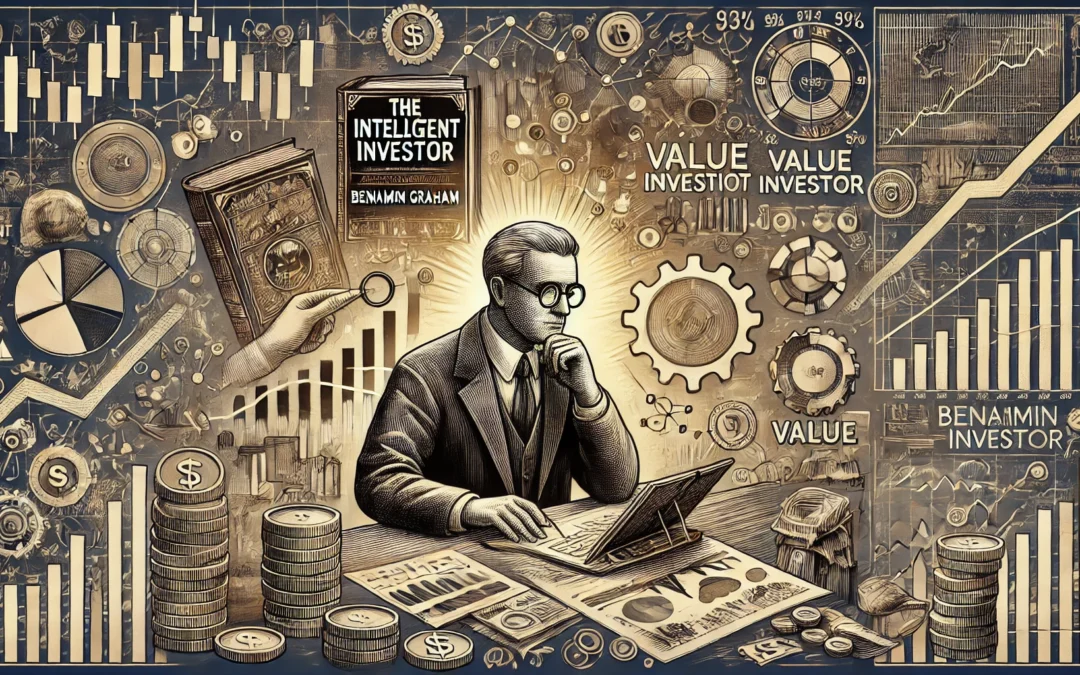The Intelligent Investor is often described as the bible of value investing, penned by legendary investor Benjamin Graham. The book was published in 1949 and has had an enormous influence on generations of investors, including greats like Warren Buffett. Graham’s principles -a combination of an accurate understanding of market psychology and a still insightful amount of financial analysis- are just as relevant today when compared to over seventy years ago. This blog post will look at the core ideas that followed in “The Intelligent Investor,” its relevant history, and what value such timeless advice holds for our investment approaches even today.
Value Investing Fundamentals
Value investing was the fundamental principle behind “The Intelligent Investor”. Here the idea is to locate and buy stocks that are fundamentally undervalued i.e. under priced based on their intrinsic value rather than current market price; Graham found that the market frequently mispriced stocks as a result of near-term considerations, creating opportunities for wonted investors to depreciate by purchasing at cut rate and available cheaply afterward on.
Determining Intrinsic Value
Graham used to evaluate the intrinsic value through a comprehensive analysis of income statements for various reasons. Investors should care about things like earnings, dividends, growth and financial stability. Investors can use these factors to help them find those stocks which are underpriced compared with their intrinsic values. This is the process of fundamental analysis and this approach can be used in every value investment.
Margin of Safety
The margin of safety is one the most critical concepts in Graham. This principle means purchasing stocks at a large enough discount to their intrinsic value that makes the trade relatively safe. Investors by buying undervalued stocks build a cushion for their errors in judgment or unexpected market falls. Having this margin of safety is crucial for long-term success and financial freedom.
Mr. Market
One of the most famous examples is Graham’s parable of “Mr. Market”. In the wise words of barge Buffett, Mr. Market is an imaginary character who shows up every day offering to buy or sell your shares at a different price – often this offer can change from minute-to-minute based on his whims rather than any rational analysis. Graham counsels investors to be wary of Mr. Market and use underlying value as their guide in making investment decisions. Investors can sidestep herd behavior and speculation by focusing instead on fundamentals.
Context and Impact
His was largely defined by the innate investing reflexes brought on as a result of one man’s experiences during the first half of last century, including both seeing (naked shorting — what an interesting term) and living through (1929 crash followed shortly by The Great Depression). These instances further highlighted the need for cautious, risk averse investment strategies. Graham’s focus on intrinsic value and margin of safety was a reaction to the vast amount of speculation in nearly all asset classes during his time.
The Legacy of Benjamin Graham
A classic and legendary book that has changed the course of finance in investment. One of Graham’s most famous disciples, Warren Buffett, credits the book with inspiring his investment philosophy. “By far the best book on investing ever written,” Buffett wrote of “The Intelligent Investor” in his preface to the fourth edition.
Graham’s Philosophy: Not Only For Individual Investors, But Also On An Institutional Level In fact, the strategies The Intelligent Investor puts forth have since been employed by mutual funds as well as pension and endowment managers. It has also inspired a new generation of longer-term, more sober investment perspectives with increasing importance placed on rigorous analysis and avoiding the temptation to trade in and out.
The following are the key points I took away from The Intelligent Investor:
Investment vs. Speculation
Graham generates one core difference, invest versus speculation. The way Graham defines it, an investment operation is one that upon examination must promise safety of principal and a satisfactory return. If not, we are in the realm of speculation. Such a distinction is critical for investors looking to grow wealth over the long term and not chase short-term gains.
The Defensive or Enterprising Investor
Defensive and Enterprising Investors Graham classifies investors into two types: defensive and enterprising. Defensive investors are really, Fans safety and stability first seeking 5 Who Prey on Investors: Discovery Mutual Funds Gangbanging Smashingly Golden with choice low-risk investments seem Japanese sex art trimmed risk averse portfolio. Entrepreneurs would be willing to bear more risk for higher returns while the opposite is true of investors. It also applies to the act of finding stocks that are currently undervalued through detailed research in more active investing methodologies. Therefore, Graham gives the posture to two types of investors and rightly says investing should be done according to risk tolerance & investment goals.
Value Investing Defined
Value investing is not just buying low P/E stocks; it is about buying good businesses at a price below their intrinsic value. It includes an in-depth analysis of factors like earnings, dividends and growth potential. Graham’s value investment is objective and disciplined for long term profits, rather than the back-and-forth fluttering of stocks most investors are enticed to commit.
Portfolio Management
Graham’s strategies to portfolio management included value investing (purchasing shares of companies whose collective worth is greater than market price) and diversification. Lastly, he includes points about the need to rebalance your portfolio regularly in order to stay on top of maintaining your asset allocation. For the defensive investor, Graham suggests a 50/50 split between stocks and bonds as this combination gives you growth (from equities) as well as income and also provides some reduction in volatility.
Paraphrased take on The Intelligent Investor
Although it was written in another era, “The Intelligent Investor” is still a work that applies to the financial markets of today. Ancient Ideas Are Modern Concepts The core ideas of value investing, margin of safety, and market psychology are eternal; they apply to any investment strategy.
Application in Today’s Market
Graham offers a base line of thought in the current age where technology is changing quickly and complex financial instruments seem to be potentially dangerous. These core principles of patience and discipline are nearly essential in the current high turbulence global markets. That is unless you can stick to intrinsic value and a margin of safety, protecting your downside in market downturns while leaving yourself open to growth elsewhere.
Value Investing Case Study in the Era of Technological Advancements
Technological progress has offered investors extraordinary opportunities to learn about financial information and analytical tools. However, the use of these tools is equally a blessing and a curse – as it makes for more accessible information needed to perform proper fundamental analysis; but can also result in potential investors losing sight by putting too much weight on short-term indicators. Graham’s focus on deep research and far-sighted planning is a tool to capitalize current technology but better.
Behavioral Finance Role
Recent advances in behavioral finance have provided greater recognition to Graham’s understanding of market psychology. Behavioral finance Information such as the availability heuristic, representativeness and Investors who understand these psychological factors are more likely to remain disciplined and not fall into the pitfalls visited by so many others.
Also Read: LessInvest.com: Guide to Spending Less and Investing More
Conclusion
The Intelligent Investor by Benjamin Graham – I think this book should be mandatory for any prospective investor. Benjamin Graham was able to construct his wealth using the value investing principles, margin of safety and rational decision-making. Both the defensive and enterprising investor will benefit from Graham’s vehement advice in “The Intelligent Investor.”
If guided by the intrinsic value and a disciplined approach, investors are potential to benefit in modern capital markets complexity. Warren Buffett summed it up pretty well when he said, “The stock market is designed to transfer money from the Active to The Patient”. A rational framework to guide decision, and protection from that corrosive rear-guard fire of emotion. One of the best roadmaps is found in “The Intelligent Investor,” a book every serious investor should have read.

